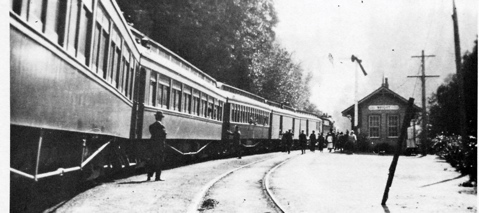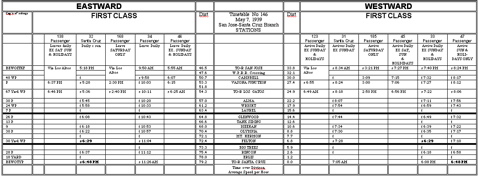
Passenger service wasn't heavy on the Vasona branch, but it's heavy enough to help make a layout interesting. I'll describe a bit about what the prototype passenger trains were like, then mention how I modeled each train. I'll detail how I've made Model Die Casting baggage cars and Ken Kidder 1960's era brass Harriman cars into better models.
The Prototype
The November 1932 public timetable showed four trains over the hill each day: train 31, 32, 33, and 34. Trains 31 and 32 (the "Santa Cruz") went via Los Gatos and the Mayfield cutoff; trains 33 and 34 went via West San Jose. Train 31 left Santa Cruz at 7:05 am, and arrived at San Francisco at 9:40 am. Train 32 left San Francisco at 4:00, and didn't begin making stops til Palo Alto. It then made stops along the Mayfield cutoff. Train 33 was an evening run from Santa Cruz to San Francisco via Los Gatos and West San Jose. It left at 6:35 pm, arriving at 3rd and Townsend at 9:30 pm. Train 34 left San Francisco at 8:05 am arriving at Santa Cruz at 11:15 am. Train 34 stopped at Campbell and Vasona Junction; for train 33, Campbell was a flag stop. Train 34 also connected with train 250 at Santa Clara (at 9:26 am) from the Oakland Pier. On Sundays, Train 33 met train 257 at Santa Clara; train 257 eventually ran to the Oakland Pier. All four trains appeared to count as commute trains. There was also one San Francisco->Los Gatos commute run in each direction, train 123 (leaving Los Gatos at 6:55 am and arriving in San Francisco at 8:25) and train 142 (leaving San Francisco at 5:18 and arriving in Los Gatos at 6:50.) The Saturday southbound, train 168, left at 1:00, arriving in Los Gatos at 2:40. The timetable shows that most commute trains also met the Peninsular Railway at Mayfield for passengers along the Mayfield cutoff.
The 1932 timetable would have the morning passenger leave from Los Gatos at 6:55 and immediately go onto the Mayfield Cutoff at Vasona Junction. Morning train #31 from Santa Cruz to San Francisco would leaving Santa Cruz at 7:00 am and take the Mayfield cutoff around 8:20 am; train 34 then appears at West San Jose around 9:30 and reaches Santa Cruz at 11:15. In the afternoon, train 32 would appear at the Vasona Junction at 5:15 p.m. and head south; the Los Gatos commute would appear at Vasona Junction around 6:30 and terminate at Los Gatos; finally, train 33 would leave Santa Cruz around 6:30 and leave via West San Jose around 8:00 pm.
Sundays and holidays in summer, Suntan Specials would head over the hills to Santa Cruz. When the Suntan Specials started in 1927, they left from San Jose. In 1932, the origin was moved to San Francisco, with at least three sections a day (routed via Los Altos), though perhaps with a section from San Jose. In 1934, another section would be added via Oakland. At its height of popularity from 1935-1939, seven double-headed sections could head over the hill on a holiday. (Dates from "Central California Railroads")

Timetable, May 1939 from copy at Santa Clara depot. Click on picture to see readable version.
This schedule didn't appear to change much in the 1930's. A May, 1939 timetable (at at the Santa Clara depot) similarly shows again that there were two daily round trips from San Jose to Santa Cruz (trains 31, 32, 33, and 34), and one daily commute trains from Los Gatos to San Francisco (M-F morning and evening, and Saturday morning and afternoon.) The 1939 timetable adds a short passenger service from San Jose to Los Gatos to position the commute trainset in Los Gatos before the morning rush hour, and returning the trainset to San Jose in the evening. Also, the 1939 timetable has all four of the Santa Cruz trains travelling via San Jose and Campbell. The 1932 timetable had two trains going via West San Jose and two via the Mayfield Cutoff.
Modeling the Passenger Trains of the Santa Cruz Branch
To match these timetables, I need two or three separate passenger trains, one for the Los Gatos commute service and one or two for the Santa Cruz service.
One train is required for the commute service from Los Gatos. This train would probably have a 4-6-2 or 4-6-0 for power, and several 72 foot commute coaches for the passengers. A photo in "California Central Coast Railways" (pg. 162) shows train 185 between Los Gatos and San Jose led by locomotive 2367 (running backwards) and four commute coaches. Engine 2375 was seen on this train in 1941.
Handling the Santa Cruz service requires either one or two trains (depending on which staging track each train ends up in, and whether the northbound and southbound trains morning and evening would be on the layout at the same time. Photos of trains 31 and 34 from the late 1930's typically were a 4-6-0, 70' baggage-postal car, and two commute coaches. "South Pacific Coast: A Centennial" shows train 31 running through Campbell; it's led by locomotive 2381 (a 4-6-0), a 70-BP-30-2 baggage-postal car, and two 72-ic-1 commute coaches. Photos from the late 1930's may be misleading, as my era's closer to the darkest days of the depression, and the lowest passenger counts. Engine 2548 (a 2-8-0) was also seen on this train in 1937 according to a photo in "California Central Coast Railways", as was 2373 and 2382.
Suntan Specials used whatever coaches were handy -- probably commute coaches. 2-8-0's, often doubleheaded, could be seen on these trains, along with larger 4-6-0's. SP Trainline (winter/spring 2005?) also mentions that:
"In the 1920's and 1930's, the Colma Vegetable Association sponsored a yearly picnic at Big Trees near Felton, CA. For this annual event, SP would divert one of the popular Sunday-only Suntan Specials (which ran in as many as five sections from San Francisco to the Santa Cruz Boardwalk) up the old Ocean View line to pick up the people. It usually consisted of about eight commute cars between two 2300-series 4-6-0's. Stops were made at Ocean View, Colma, and Baden before the train proceeded to San Bruno to join the main line to San Jose. At Mayfield, it took the cutoff through Los Altos and Vasona Junction to Los Gatos and over the Santa Cruz Mountains to Big Trees. In the evening, the train re-traced the same route to return the picnickers."
For now, I'm using the 1939 schedule for my passenger trains even though I'm modeling 1932. By doing so, the passenger trains pass through Campbell and West San Jose, and thus make switching these areas a bit more interesting. Also, I can immediately turn the train from Santa Cruz on a reversing loop after it leaves West San Jose, and have it become the train to San Jose. Also, having the early morning and late evening San Jose to Los Gatos service again makes passenger trains more visible to operators.
With this schedule, I need one train to represent the Los Gatos commute train, and one to represent #31-34 "Santa Cruz Passenger". The commute train is simply two Soho brass Harriman commute cars (72-IC-1). The 31-34 is represented by a few 60-C-4 coaches -- short Harriman coaches -- and a baggage or RPO car (to replace the baggage/RPO seen in pictures). Occasional Suntan Specials use as many coaches as I can gather.
Appendix: Sample train rosters for the 1930's
Here are some sample train consists -- lists of locomotives and cars -- for trains on the Vasona branch in the 1930's. All were gathered from photos. Each lists the engine and cars on each train, and specifies the railroad's class of car when known.
#185 Los Gatos to San Jose, March 1939, at Vasona Junction (Central California Coast Railways, p. 162):
Power: #2367 (4-6-0) backwards
4 72-IC-x commute coaches
#31 -- San Francisco / Santa Cruz Passenger, 1938, Camden Ave., Campbell (South Pacific Coast: A Centennial p.149)
Power: Locomotive 2381 (4-6-0)
Baggage-Postal 70-BP-30-2
72-IC-x commute coach
72-IC-x commute coach
#31 (morning train Los Gatos->San Francisco), March 11, 1941, Los Gatos (Central California Coast Railways p.165)
Power:Locomotive 2375 (4-6-0) facing towards San Jose
Unknown RPO
Rest unknown
#32 evening train San Francisco->Santa Cruz just arrived, 1930's, Santa Cruz (Central California Coast Railways p 155)
Power:Locomotive #3108 (4-6-2)
Baggage-RPO
rest unknown
Santa Cruz Passenger #34, 1937, Tunnel 5, Santa Cruz Mountains (Central California Coast Railways p 155)
Power: locomotive 2548 (2-8-0)
rest unknown
Train: #34, Santa Cruz Passenger leaving San Jose, January 24,1938, San Jose (just south of new San Jose station) (Prune County Railroading p. 86; Central California Coast Railways p 163; SP Bay Area Steam p. 54 )
Power: Locomotive 2373 4-6-0
Baggage Postal 70-BP-30-2
Coach
Coach
#34 Santa Cruz Passenger, 1939, near Alma (South Pacific Coast: A Centennial p185. Also SP Bay Area Steam p.70)
Power:Locomotive 2382 (4-6-0)
Baggage Postal BP-70-30-1
Coach 72-ic-x commute coach with square vents
Coach 72-ic-x commute coach with square vents
rest of train obscured
San Jose-bound Passenger train, late 1930's, Santa Cruz Mountains (SP Bay Area Steam p. 68)
Power: 4-6-0
Baggage Postal 70-BP-30-1
4 coaches
Train: train 137, San Jose to San Francisco stopping in Palo Alto, Redwood City, San Mateo, and Burlingame, 1935, San Jose Market Street station (Coast Line, P. 100)
Power: Locomotive 2483 (4-6-2)
Coach 60-C-1 coach?
Coach
Coach
Passenger train, 1930, 3rd and Townsend station, San Francisco (SP Bay Area Steam, p. 34)
Power:Locomotive 3107 (4-6-2)
RPO
rest of train obscured
Train: 142 (San Francisco->Los Gatos, 5:18 pm departure, early 1940's, 3rd and Townsend station, San Francisco (SP Bay Area Steam, p. 32)
Power: Locomotive 2401 (4-6-2)
Coach Clerestory roof coach
Coach Clerestory roof coach
Coach Clerestory roof coach
Suntan Special, 1939, Felton siding (South Pacific Coast: A Centennial: p 261)
Power: Locomotive 2781 (2-8-0)
Power: Locomotive 2764 (2-8-0)
rest unknown
Suntan Special, 1930's, Santa Cruz street (Central California Coast Railways p260)
Power: Locomotive 2380 (4-6-0)
Power: Locomotive ???
Coach 72-IC-1 commute coach
Coach 72-IC-1 commute coach
Coach 72-IC-1 commute coach
Coach 72-IC-1 commute coach
Coach 72-IC-1 commute coach
Last section, Suntan Special, July 6, 1941, Santa Cruz Yard (Central California Coast Railways p. 261)
Power: Locomotive 2332 (4-6-0)
Power: Locomotive ????
Rest obscured
Sources for SP Harriman Cars
| 60-B-9 Baggage: | Model Die Casting |
| 60-P-1..4 RPO: | Southern Car and Foundry 60' RPO |
| 60-BP-30-1 Baggage Postal | Ken Kidder |
| 69-BP-30-1..4 Baggage/Postal | Southern Car and Foundry 69' Baggage Postal |
| 70-B-x Baggage | Southern Car and Foundry resin kits |
| 60-C-1..4 Coach | Ken Kidder brass |
MDC Harriman: The MDC Harriman body is the correct length. The trucks need to be moved out so they're 52' apart -- about 3' out on each end. The underframe also needs to be detailed, couplers body mounted, etc. Ventilators should be utility ones (PSC 33186, 6 or 7 needed)
There's a Picture of 60-B-9 (or so) on page 106 of "Night Trains of the coast" -- no batt box visible, at least one tank and page 146.